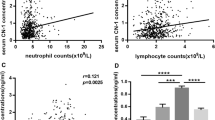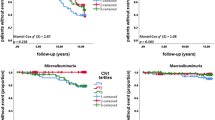Abstract
Purpose
Oxidative stress and dyslipidemia have been found to be associated with the progression of chronic kidney disease (CKD) in type 2 diabetes mellitus (T2DM) patients. Paraoxonase 1 (PON-1) activity, and proprotein convertase subtilisin kexin type 9 (PCSK9) levels play an important role regarding anti-oxidants, and lipid metabolism, respectively. The aim of this study was to investigate the association of PON-1 activity, and PCSK9 levels with CKD in T2DM.
Methods
A total of 180 T2DM (87 CKD, and 93 non-CKD) with age-, and gender-matched subjects were recruited in this study. PON-1 activity was measured with two kinds of substrate: paraoxon for paraoxonase (PONase) activity and phenylacetate for arylesterase (AREase) activity. PCSK9 levels were measured by enzyme-linked immunosorbent assay (ELISA).
Results
AREase activity was significantly lower in CKD compared with non-CKD (225.53 ± 108.73 vs. 257.45 ± 106.12 kU/L, p = 0.044) in T2DM, whereas there was no significant difference in PONase activity and PCSK9 levels between CKD and non-CKD groups. In addition, multivariate logistic regression analysis showed that the lowest tertile of AREase increased the risk for CKD in T2DM (OR 3.251; 95% CI 1.333–7.926, p = 0.010), whereas PONase activity and PCSK9 levels were not associated with CKD in T2DM.
Conclusion
Reduced AREase activity can increase the risk for CKD in T2DM patients. AREase activity, but not PONase activity and PCSK9 levels, may be used as the biomarker for predicting the progression of CKD in T2DM.

Similar content being viewed by others
References
Klein R (1995) Hyperglycemia and microvascular and macrovascular disease in diabetes. Diabetes Care 18:258–268
Lin YC, Chang YH, Yang SY, Wu KD, Chu TS (2018) Update of pathophysiology and management of diabetic kidney disease. J Formos Med Assoc 117(8):662–675
Chen SC, Tseng CH (2013) Dyslipidemia, kidney disease, and cardiovascular disease in diabetic patients. Rev Diabet Stud 10(2–3):88–100
Eren E, Yilmaz N, Aydin O (2013) Functionally defective high-density lipoprotein and paraoxonase: a couple for endothelial dysfunction in atherosclerosis. Cholesterol. https://doi.org/10.1155/2013/792090
Mackness M, Mackness B (2015) Human paraoxonase-1 (PON1): gene structure and expression, promiscuous activities and multiple physiological roles. Gene 567(1):12–21
Moradi H, Pahl MV, Elahimehr R, Vaziri ND (2009) Impaired antioxidant activity of high-density lipoprotein in chronic kidney disease. Transl Res 153:77–85
Kennedy DJ, Tang WH, Fan Y, Wu Y, Mann S, Pepoy M, Hazen SL (2013) Diminished antioxidant activity of high-density lipoprotein-associated proteins in chronic kidney disease. J Am Heart Assoc 2:e000104
Lambert G, Sjouke B, Choque B, Kastelein JJ, Hovingh GK (2012) The PCSK9 decade. J Lipid Res 53:2515–2524
Alonso R, Mata P, Muñiz O, Fuentes-Jimenez F, Díaz JL, Zambón D, Tomás M, Martin C, Moyon T, Croyal M, Thedrez A, Lambert G (2016) PCSK9 and lipoprotein (a) concentrations are two predictors of coronary artery calcification in asymptomatic patients with familial hypercholesterolemia. Atherosclerosis 254:249–253
Lan H, Pang L, Smith MM, Levitan D, Ding W, Liu L, Shan L, Shah VV, Laverty M, Arreaza G, Zhang Q, Murgolo NJ, Hernandez M, Greene JR, Gustafson EL, Bayne ML, Davis HR, Hedrick JA (2010) Proprotein convertase subtilisin/kexin type 9 (PCSK9) affects gene expression pathways beyond cholesterol metabolism in liver cells. J Cell Physiol 224:273–281
Feingold KR, Moser AH, Shigenaga JK, Patzek SM, Grunfeld C (2008) Inflammation stimulates the expression of PCSK9. Biochem Biophys Res Commun 374:341–344
Ferri N, Corsini A, Macchi C, Magni P, Ruscica M (2016) Proprotein convertase subtilisin kexin type 9 and high-density lipoprotein metabolism: experimental animal models and clinical evidence. Transl Res 173:19–29
Konarzewski M, Szolkiewicz M, Sucajtys-Szulc E, Blaszak J, Lizakowski S, Swierczynski J, Rutkowski B (2014) Elevated circulating PCSK-9 concentration in renal failure patients is corrected by renal replacement therapy. Am J Nephrol 40:157–163
Jin K, Park BS, Kim YW, Vaziri ND (2014) Plasma PCSK9 in nephrotic syndrome and in peritoneal dialysis: a cross-sectional study. Am J Kidney Dis 63:584–589
Cariou B, Le Bras M, Langhi C, Le May C, Guyomarc'h-Delasalle B, Krempf M, Costet P (2010) Association between plasma PCSK9 and gamma-glutamyl transferase levels in diabetic patients. Atherosclerosis 211:700–702
Elewa U, Fernández-Fernández B, Mahillo-Fernández I, Martin-Cleary C, Sanz AB, Sanchez-Niño MD, Ortiz A (2016) PCSK9 in diabetic kidney disease. Eur J Clin Invest 46:779–786
Morena M, Le May C, Chenine L, Arnaud L, Dupuy AM, Pichelin M, Leray-Moragues H, Chalabi L, Canaud B, Cristol JP, Cariou B (2017) Plasma PCSK9 concentrations during the course of nondiabetic chronic kidney disease: relationship with glomerular filtration rate and lipid metabolism. J Clin Lipidol 11:87–93
Rogacev KS, Heine GH, Silbernagel G, Kleber ME, Seiler S, Emrich I, Lennartz S, Werner C, Zawada AM, Fliser D, Böhm M, März W, Scharnagl H, Laufs U (2016) PCSK9 plasma concentrations are independent of GFR and do not predict cardiovascular events in patients with decreased GFR. PLoS ONE 11:e0146920
Zhang HW, Zhao X, Xu RX, Guo YL, Zhu CG, Wu NQ, Cui CJ, Dong Q, Li JJ (2018) Relationship between plasma proprotein convertase subtilisin/kexin type 9 and estimated glomerular filtration rate in the general Chinese population. Cardiorenal Med 8:311–320
World Health Organization; International Diabetes Federation (2006) Definition and diagnosis of diabetes mellitus and intermediate hyperglycaemia: report of a WHO/IDF consultation. World Health Organization, Geneva
Charles RH, Terry AJ (2008) Managing dyslipidemia in chronic kidney disease. J Am Coll Cardiol 51:2375–2384
Nagila A, Permpongpaiboon T, Tantrarongroj S, Porapakkham P, Chinwattana K, Deakin S, Porntadavity S (2009) Effect of atorvastatin on paraoxonase1 (PON1) and oxidative status. Pharmacol Rep 61:892–898
Keskin M, Dolar E, Dirican M, Kiyici M, Ylmaz Y, Gurel S, Nak SG, Erdinc S, Gulten M (2009) Baseline and salt-stimulated paraoxonase and arylesterase activities in patients with chronic liver disease: relation to disease activity. Inter Med J 39:243–248
Huen K, Richter R, Furlong C, Eskenazi B, Holland N (2009) Validation of PON1 enzyme activity assays for longitudinal studies. Clin Chim Acta 402:67–74
Okuturlar Y, Akalin N, Kaptanogullari OH, Guner NT, Yilmaz D, Gedikbasi A, Soyluk O, Mert M, Serin SO, Kocoglu H, Hursitoglu M, Kumbasar A (2016) Comparison of serum paraoxonase and arylesterase activities between iron deficiency anemia patients and chronic kidney disease patients with anemia. Ren Fail 38(5):781–786
Rapa SF, Di Iorio BR, Campiglia P, Heidland A, Marzocco S (2019) Inflammation and oxidative stress in chronic kidney disease-potential therapeutic role of minerals, vitamins and plant-derived metabolites. Int J Mol Sci. https://doi.org/10.3390/ijms21010263
Zhou H, Tan K, Shiu S, Wong Y (2007) Increased serum advanced glycation end products are associated with impairment in HDL antioxidative capacity in diabetic nephropathy. Nephrol Dial Transpl 23:927–933
Mackness MI, Arrol S, Abbott C, Durrington PN (1993) Protection of low-density lipoprotein against oxidative modification by high-density lipoprotein associated paraoxonase. Atherosclerosis 104:129–135
Himmelfarb J, Stenvinkel P, Ikizler TA, Hakim RM (2002) The elephant in uremia: oxidant stress as a unifying concept of cardiovascular disease in uremia. Kidney Int 62:1524–1538
Ferretti G, Bacchetti T, Masciangelo S, Pallotta G (2008) Lipid peroxidation in hemodialysis patients: effect of vitamin C supplementation. Clin Biochem 41(6):381–386
Amengual-Cladera E, Nadal-Casellas A, Gómez-Pérez Y, Gomila I, Prieto RM, Proenza AM, Lladó I (2011) Phytotherapy in a rat model of hyperoxaluria: the antioxidant effects of quercetin involve serum paraoxonase 1 activation. Exp Biol Med (Maywood) 236(10):1133–1138
Sucajtys-Szulc E, Szolkiewicz M, Swierczynski J, Rutkowski B (2016) Up-regulation of liver Pcsk9 gene expression as a possible cause of hypercholesterolemia in experimental chronic renal failure. Mol Cell Biochem 411:281–287
Joles JA, Kunter U, Janssen U, Kriz W, Rabelink TJ, Koomans HA, Floege J (2000) Early mechanisms of renal injury in hypercholesterolemic or hypertriglyceridemic rats. J Am Soc Nephrol 11(4):669–683
Konrad RJ, Troutt JS, Cao G (2011) Effects of currently prescribed LDL-C-lowering drugs on PCSK9 and implications for the next generation of LDL-C-lowering agents. Lipids Health Dis 10(38):2–10
Charytan DM, Sabatine MS, Pedersen TR, Im K, Park JG, Pineda AL, Wasserman SM, Deedwania P, Olsson AG, Sever PS, Keech AC, Giugliano RP, FOURIER Steering Committee Investigators (2019) Efficacy and safety of evolocumab in chronic kidney disease in the FOURIER trial. J Am Coll Cardiol 73(23):2961–2970
Cariou B, Le May C, Costet P (2011) Clinical aspects of PCSK9. Atherosclerosis 216(2):258–265
Caselli C, Del Turco S, Ragusa R, Lorenzoni V, De Graaf M, Basta G, Scholte A, De Caterina R, Neglia D (2019) Association of PCSK9 plasma levels with metabolic patterns and coronary atherosclerosis in patients with stable angina. Cardiovasc Diabetol 18:144. https://doi.org/10.1186/s12933-019-0949-3
Paradis G, Lambert M, O’Loughlin J, Lavallée C, Aubin J, Berthiaume P, Ledoux M, Delvin EE, Lévy E, Hanley JA (2003) The Quebec Child and Adolescent Health and Social Survey: design and methods of a cardiovascular risk factor survey for youth. Can J Cardiol 19:523–531
Druce I, Abujrad H, Ooi TC (2015) PCSK9 and triglyceride-rich lipoprotein metabolism. J Biomed Res. https://doi.org/10.7555/JBR.29.20150052
Rashid S, Tavori H, Brown PE, Linton MF, He J, Giunzioni I, Fazio S (2014) Proprotein convertase subtilisin kexin type 9 promotes intestinal overproduction of triglyceride-rich apolipoprotein B lipoproteins through both low-density lipoprotein receptor-dependent and -independent mechanisms. Circulation 130:431–441
Drouin-Chartier JP, Tremblay AJ, Hogue JC, Lemelin V, Lamarche B, Couture P (2018) Plasma PCSK9 correlates with apoB-48-containing triglyceride-rich lipoprotein production in men with insulin resistance. J Lipid Res 59:1501–1509
Rosenblat M, Ward S, Volkova N, Hayek T, Aviram M (2012) VLDL triglycerides inhibit HDL-associated paraoxonase 1 (PON1) activity: in vitro and in vivo studies. BioFactors 38:292–299
Koren-Gluzer M, Aviram M, Meilin E, Hayek T (2011) The antioxidant HDL-associated paraoxonase-1 (PON1) attenuates diabetes development and stimulates β-cell insulin release. Atherosclerosis 219:510–518
Passaro A, Vigna GB, Romani A, Sanz JM, Cavicchio C, Bonaccorsi G, Valacchi G, Cervellati C (2018) Distribution of paraoxonase-1 (PON-1) and lipoprotein phospholipase A2 (Lp-PLA2) across lipoprotein subclasses in subjects with type 2 diabetes. Oxid Med Cell Longev. https://doi.org/10.1155/2018/1752940
Sumegová K, Nagyová Z, Waczulíková I, Zitnanová I, Duracková Z (2007) Activity of paraoxonase 1 and lipid profile in healthy children. Physiol Res 56:351–357
Karakaya P, Ozdemir B, Mert M, Okuturlar Y (2018) Relation of paraoxonase 1 activity with biochemical variables, brachial artery intima-media thickness in patients with diabetes with or without obesity. Obes Facts 11:56–66
Funding
Walailak University fund (WU-IRG-62-020, and No. 08/2562). This research was partially supported by the New Strategic Research (P2P) project (phase 2), Walailak University, Thailand.
Author information
Authors and Affiliations
Contributions
ND contributed to perform the experiment, and interpretation of the data, WT contributed to the patient recruitment and discussion. SP contributed to the protocol development and results discussion. NJ contributed to the involved in gaining ethical approval, data analysis and interpretation, and the development of the manuscript.
Corresponding author
Ethics declarations
Conflict of interest
All authors declare that they have no conflict of interest.
Informed consent
Informed consent was obtained from all individual participants included in the study.
Additional information
Publisher's Note
Springer Nature remains neutral with regard to jurisdictional claims in published maps and institutional affiliations.
Rights and permissions
About this article
Cite this article
Didas, N., Thitisopee, W., Porntadavity, S. et al. Arylesterase activity but not PCSK9 levels is associated with chronic kidney disease in type 2 diabetes. Int Urol Nephrol 52, 1725–1732 (2020). https://doi.org/10.1007/s11255-020-02547-2
Received:
Accepted:
Published:
Issue Date:
DOI: https://doi.org/10.1007/s11255-020-02547-2




